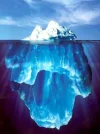nivrip
Yorkshire Cruncher
- Joined
- Mar 21, 2007
- Messages
- 11,485
- Reaction score
- 2,230
This came from a Rig Manager
for Global Marine Drilling
in St. Johns , Newfoundland ..
They actually have to divert the path
of these things away from the rig
by towing them with ships!
Anyway, in this particular case
the water was calm and
the sun was almost directly overhead
so that the diver was able to get into the water
and take this picture.
They estimated the weight at 300,000,000 tons.

Fantastic.
It would have been nice to have something alongside it to get a true idea of its size. But, you can't have everything.
for Global Marine Drilling
in St. Johns , Newfoundland ..
They actually have to divert the path
of these things away from the rig
by towing them with ships!
Anyway, in this particular case
the water was calm and
the sun was almost directly overhead
so that the diver was able to get into the water
and take this picture.
They estimated the weight at 300,000,000 tons.
Fantastic.

It would have been nice to have something alongside it to get a true idea of its size. But, you can't have everything.












 , phew!!!
, phew!!! 